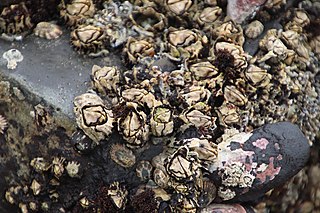
Thoracica is an infraclass of crustaceans which contains the most familiar species of barnacles found on rocky coasts, such as Semibalanus balanoides and Chthamalus stellatus. They have six well-developed limbs, and may be either stalked or sessile. The carapace is heavily calcified. The group includes free-living and commensal species.

The Chthamalidae are a family of chthamaloid barnacles, living entirely in intertidal/subtidal habitats, characterized by a primary shell wall of eight, six, or four plates, lacking imbricating plate whorls, and either membraneous or more rarely calcareous basis. They are not found below immediate subtidal habitats, and more likely are found in the highest tier of shallow-water barnacle fauna. They can be found in the most rigorous wave-washed locations, and some species are found in the surf zone above high tide mark, only receiving water from wave action at high tide. The family includes at least 56 recognized species.

Ascothoracida is a small group of parasitic marine crustaceans, comprising around 100 species and divided into Dendrogastrida and Laurida. They are found throughout the world on cnidarians and echinoderms. Dendrogastrida are parasites on echinoderms, and Laurida are parasites on cnidarians, except from the species Waginella Grygier, which is also a parasite on echinoderms (crinoids). Piercing and sucking mouthparts are used for feeding, and more advanced forms also absorbs nutrients through a modified integument of the carapace. More basal forms are ectoparasitic, but most genera are meso- and endoparasitic. The sexes are separate, except from secondary hermaphroditic species of the Petrarcidae. In many species the larger female often have smaller males living inside her mantle cavity.

Chthamalus is a genus of barnacles that is found along almost all non-boreal coasts of the northern hemisphere, as well as many regions in the southern hemisphere. These small barnacles have been studied in part because of the taxonomic confusion over a group of species that, by and large, are morphologically and ecologically quite similar. In recent years, molecular techniques have identified a number of cryptic species that have been subsequently confirmed by taxonomists using morphological measurements. Most recently the genus has been shown to be paraphyletic, with the genus Microeuraphia nested within Chthamalus.

The Acrothoracica are an infraclass of barnacles.

Notochthamalus scabrosus, the only species in the genus Notochthamalus, is a species of barnacle found along the south-western and south-eastern coasts of South America, from Peru to the Falkland Islands. The species is found almost exclusively higher in the intertidal zone than the mussel Perumytilus, often codistributed with the confamilial barnacle Jehlius cirratus and Balanus flosculus.
Dipterosaccus is a genus of barnacle.
Conopea is a genus of barnacle, containing the following species:

The Chthamaloidea are a subdivision of Balanomorpha proposed by Newman and Ross to include barnacles with shell wall composed of rostrum, carina, and one to three pairs of latera, rarely supplemented with one or more whorls of basal imbricating plates. The rostrolatus enters the sheath, but rarely fuses with the rostrum, as in the three higher superfamilies. Shell plates are simple in construction, solid, and incorporate organic chitin between carbonate layers. Opercular plates are deeply interlocked, and in some genera, may become concrescent with age. Soft part morphology includes concave labrum without notch in the central part. Cirrus III more resembles Cirrus IV than II, or may be intermediate in structure. Caudal appendages present in some species.
The Catophragmidae are a family of barnacles in the superfamily Chthamaloidea with eight shell wall plates, surrounded by several whorls of imbricating plates. The basis is membranous.

Catomerus is a monotypic genus of intertidal/shallow water acorn barnacle that is found in warm temperate waters of Australia. The genus and species is very easily identified by whorls of small plates surrounding the base of the primary shell wall; no other shoreline barnacle species in the Southern Hemisphere has that feature. This species is considered to be a relic, as these plates are found only in primitive living lineages of acorn barnacles or in older fossil species. The fact that this is an intertidal species is unusual, because living primitive relic species are often found in more isolated habitats such as deep ocean basins and abyssal hydrothermal vents.
Chamaesipho is a genus of four-plated notochthamaline barnacles in the Pacific Ocean limited to Australian/New Zealand temperate waters. They are intertidal in preference, and tend to form crowded columnar colonies. They can be identified in the field by having a four-plated wall, an unfused rostrum, and narrow opercular plates. Elminius, which also inhabits the same area, has four plates in its shell wall. However, in Elminius, the rostrum and rostrolatera are fused completely, and the compound rostrum receives the alae of the adjacent carinolaterals. In Chamaesipho, the unfused rostrum bears alae, and closely resembles the carina in appearance.

Chamaesipho tasmanica is an intertidal shoreline barnacle of Australia. Its principal range centers in New South Wales, and Tasmania. Columnar colonies can be found on high intertidal rocks relatively free of dense seaweed. Individuals are small, less than 15 mm, and grayish in color.

Chamaesipho columna is the type species for the barnacle genus Chamaesipho. Originally, species concept, as refined by Darwin472 consisted of C. columna. Spengler's 1790 description included specimens from "Otaheite" (Tahiti), which were far larger than any of the three described species. As Chamaesipho is restricted to Australia and New Zealand, and Spengler's Tahiti material lacked opercular plates, it is no longer included as Chamaesipho. Spengler's written description agrees with Chamaesipho.472 Spengler's Tahiti material is thought to be New Zealand Epopella, mislabeled.
Chamaesipho grebneffi is the first extinct member of the Notochthamalinae to be described, and the oldest chthamaloid barnacle known. This species is a fully derived Chamaesipho, and indicates a considerable antiquity for Chthamaloidea.
Rehderella is an unusual and monotypic barnacle genus restricted to Easter Island and Pitcairn Island. Rehderella belyaevi is its only species.
The barnacle genus Nesochthamalus was erected by Foster & Newman, 1987, to include sole species Chthamalus intertextus originally named by Darwin in 1854. It is widespread on islands in Western Pacific Ocean, including Hawaii, and presents combinations of unusual features which make easily recognizable for field workers. These include dirty white shell exterior with deep purple colored interior, operculars colored purple. Opercular plates on each side calcify together in all but youngest individuals, and cannot be separated or easily distinguished from each other. This feature is shared only by Rehderella belyaevi, but in latter species, scutum and tergum can be distinguished by raised ridge replacing old articular margin. Unique feature of Nesochthamalus is its basis. In young individuals, it is entirely membraneous, and with age, becomes secondarily calcareous progressively inwards, leaving only the center membraneous. As the basis calcifies, it rises off the substrate forming a saucer shape when viewed from the side. In addition, interior of shell is secondarily calcified.

Octomeris is a genus of star barnacles in the family Chthamalidae. There are at least three described species in Octomeris.

Microeuraphia is a genus of star barnacles in the family Chthamalidae. There are about eight described species in Microeuraphia.









